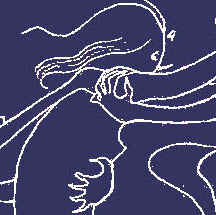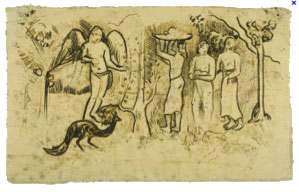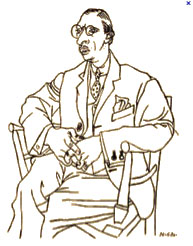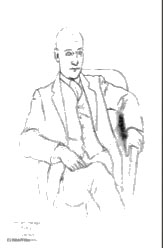Exploring the History of Contour Drawings
Contour line drawing is a unique form of artistic expression. Contour was originally a French word meaning "circumference" or "outline." 1A contour drawing occurs when an artist completes a line drawing that only provides the outline of the subject. The result is a simple two dimensional figure that avoids the suggestion of volume and mass by forgoing shading or modeling. A continuous contour line drawing is more rare, but is executed by creating a work without lifting the pencil or displaying a break in the lines of the resulting image. For Brooks, the uninterrupted quality of the line was formally the most important aspect of this technique.
Drawings slideshow
Contour drawing has always been an integral aspect of fine art as a discipline. In looking at the history of contour line drawings and its uses within this discipline, the writings of Giorgio Vasari are extremely helpful. As the most articulate art historian of the Italian Renaissance, Vasari discussed the practical values of line in relation to the Paragone, or the ongoing debate between the superiority of painting versus sculpture. Vasari deemed the flat effect of a contour line, “‘the most masterful’ form of drawing.”2As a prolific draughtsman himself, he asserted, “rather than rely on wash for shading,” an artist, “should maximize the white of the paper’s surface itself.”3 Ultimately, Vasari declared, “that line drawings without any addition of chiaroscuro were an indication of consummate skill.” 4

"No Pleasant Memories"
Quotes from the unpublished memoirs of Romaine Brooks
Vasari was not the only sixteenth century artist to believe in the power of a simple line drawing. According to Bronzino, "all that pertains to art are the lines that circumscribe a body, which are on the surface; therefore, the three-dimensional does not appertain to art but to nature."5 This emphasis of line in art over dimensionality in nature would prevail in later references to contour drawing in the twentieth century. For example, avant-garde modernist, Paul Gauguin, recorded his thoughts as follows: "Art is not nature… we cannot create a succession and recession of planes. Let us therefore acknowledge and exploit the convention of the outline, the contour."6 Within the example provided in the bulletin titled, Natives and Peacocks (c.1895-1903; above slideshow) Gauguin’s Tahitian drawings reflect this attitude through, “bold, undisguised outlines.”7 For Gauguin, then, contour represented a decisive move toward art and away from nature. For Brooks it would move one step further, to the realm of private, unconscious thought and feeling.
Other modernists also sought out this technique to innovate in the realm of art. It is no surprise that Picasso briefly tried out contour drawing, considering his prolific and experimental nature. An overview of Picasso’s drawings from his neoclassical phase (roughly starting around 1915) highlights his ability to, “synthesize a naturalistic representation by clearing out all superfluous information.”8 Picasso’s Portrait of Igor Stravinsky (1920; above slideshow), and his Portrait of Max Jacob (1915; above slideshow), are two examples of the continuous contour line technique. The sinuous lines of the drawings appear to encircle the figures making their chairs and the sitter one being that is fixed to the two-dimensional plane on which they were drawn. These images also show how, like Brooks, he was able to, “deconstruct the sitter to the bare essence of line.”9 As one of Picasso’s contemporaries it is easy to assume the practice was adopted from the master himself, but surprisingly, it was Brooks who first utilized this technique from a very early age, almost 20 years before.
While most of the artists above seem to agree on the importance of contour drawing as a skill, they differ in their application of its function. Vasari and Bronzino considered drawing an accessory to painting and sculpture, literally a stepping stone in their creative process rather than an independent form of artistic expression. Vasari asserted, "Whoever understands and manages these lines well will, with the help of practice and judgment, excel in each one of these arts." 10 Western art went through a transition during the eighteenth century where drawing as a separate medium of expression became more accepted. According to Elsa Smithgall, the curator of a small 2012 exhibit on French drawings at the Phillips Collection, this change was brought on by a growing desire from collectors to view drawings, “alongside paintings in the official French Salons.” 11 By the nineteenth century, members of the French avant-garde such as Gauguin and Picasso had finally elevated the medium of drawing from a mere stepping stone to an artistic expression in its own right. Following this more modernist practice, Brooks’ contour drawings were finished works, never intended to be translated onto canvas. Surprisingly, her paintings rarely even suggested stylistic similarities to these unique works. Upon first glance, one would find it difficult to believe that her portraits and her drawings could be done by the same artist.
Footnotes
Harper, Douglas. Online Entymology Dictionary. http://www.etymonline.com/index.php?term=contour. 2001-2012.↑
Fredrika H. Jacobs “An Assessment of Contour Line: Vasari, Cellini and the ‘Paragone’.” Artibus et Historiae, Vol.9, No. 18 (1988), 140-141. Originally found in G. Vasari, Le vite de' piu eccellenti pittori scultori ed archittetori, ed. G. Milanesi, Florence, 1906, Della pittura, chapters l-lIl, I, pp. 175.↑
Jacobs, 141. Originally in Vasari, 175.↑
Jacobs, 141. Originally in Vasari, 175. ↑
Fredrika H. Jacobs “An Assessment of Contour Line: Vasari, Cellini and the ‘Paragone’.” Artibus et Historiae, Vol.9, No. 18 (1988), 148. Originally in P.Barocchi, ed., Scritti d'arte del cinquecento, Milan-Naples, 1971-76, I, pp. 502.↑
R.M.F. “Notes on Some Modern Drawings.” Bulletin of the Art Institute of Chicago (1907-1951), Vol. 21, No. 3 (Mar.,1927), 36.↑
R.M.F. “Modern Drawings,” 36.↑
Lisa Dinhofer. “Picasso the Draftsman.” American Artist Drawing 5.16 (2008): 90-97.↑
Lisa Dinhofer, 90-97.↑
Jacobs, 141. Originally in Vasari, 171.↑
Elsa Smithgall. “French Drawings from the Aaronsohn Collection.” Estate of Stuart Davis/Licensed by VAGA, New York, NY (2012): 3. ↑




